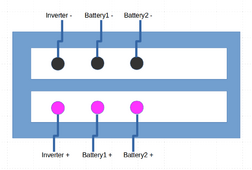kolek
Inventor of the Electron
- Joined
- Sep 29, 2021
- Messages
- 796
@hwy17 @Hedges @timselectric @sunshine_eggo @robbob2112 and anyone else:
This is the wiring order on the busbar:
Inverter minus - battery1 minus - battery2 minus
Inverter plus - battery1 plus - battery2 plus
Is that wrong, and it should be "across" like this:
Inverter minus - battery1 minus - battery2 minus
battery1 plus - battery2 plus - Inverter plus
I believe that is what @robb2112 is saying but before I rewire I'd like to hear from others on this.
This is the wiring order on the busbar:
Inverter minus - battery1 minus - battery2 minus
Inverter plus - battery1 plus - battery2 plus
Is that wrong, and it should be "across" like this:
Inverter minus - battery1 minus - battery2 minus
battery1 plus - battery2 plus - Inverter plus
I believe that is what @robb2112 is saying but before I rewire I'd like to hear from others on this.
Last edited:





